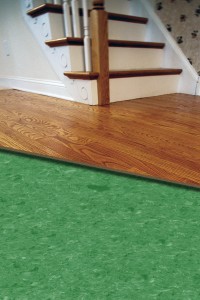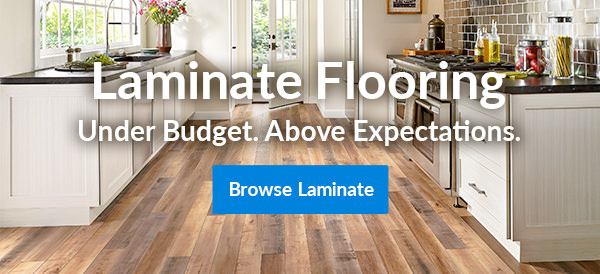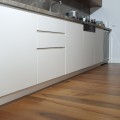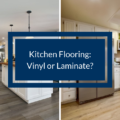Laminate Flooring Underlayment

Underlayment is a vital addition to your laminate floor installation and serves many functions. It adds a level of comfort to laminate floors, provides soundproofing qualities, and protects the flooring from moisture. It also ensures that the installation surface is perfectly level.
Here are some of the main types of underlayment that are most commonly used with laminate and other types of wood flooring. Each has different characteristics and will add a specific benefit to your flooring project.
Laminate Underlayment Options
Standard Foam Underlayment
This is the most common laminate underlayment available. This thin, foam padding usually measures 1/8 inch thick, and is available in different roll sizes.
Foam underlayment does not have a built-in moisture barrier. It’s best for areas where you expect minimal moisture. However, you can use it in conjunction with a plastic sheet if moisture is expected. You should not typically use foam underlayment with laminate flooring, as it provides minimal sound reduction.
Combination Underlayment
Combination underlayment is essentially the same as a standard foam type, but comes with a moisture barrier attached. This prevents moisture from seeping into your laminate from underneath. Install it in areas with higher levels of expected moisture, such as basements or kitchens. Its thickness is the same as a standard foam type and is sold in various-size rolls.
Acoustical/Sound Dampening Underlayment
This type of underlayment reduces the hollow sound from walking on a laminate floor. It is available in a variety of materials like cork and felt, and usually comes with a moisture barrier. Install acoustical underlayment without a moisture barrier attached together with a moisture barrier placed directly over the subfloor.
Vinyl-Backed Underlay
Vinyl-backed is a practical option because it comes in an easy-to-install tile form. It lays flat during installation and provides noise-proofing qualities. The seams must be sealed, though, if moisture-proofing is a priority.
For any project, it is best to ask the opinion of experts who can help you make the best choice for your space. Talk with a knowledgeable BuildDirect product expert for more advice on the best laminate underlayment to use in your flooring installation.






Bill
I am confused. A couple of sites have said to NOT install a moisture barrier on top of plywood subflooring. I want to float an engineered floor on top of a raised plywood subfloor. Should I use a moisture barrier or not? The plywood subfloor is about 2 to 3 feet above ground.
Thanks,
Bill
Cheryl
Hi, we are going to lay laminate flooring in our living room, and it was suggested to us to use flat tar paper as an underlay (according to this person who has sold laminate for 25 years). Just wanted to check and get your opinion.
Dennis
I am installing laminate flooring in my basement. I have already installed a DriCore subfloor over the concrete floor, and I am looking at purchasing a laminate with an attached underpad. Can I still use a 3 in 1 underlayment between the dricore and the laminate. I want the basement warm, quiet and moisture free. What route would you recommend? Would I receive any benefit from doing this?
Thanks
Alphonso
I have the Zito Acoustical felt underlayment, the felt side goes on the concrete, and can i put it right up to the base boards or should I leave a gap?
It’s imported by Verital.
Thanks
Ginny
On a cement basement floor, can I install a electric heating mesh under the laminate? What order does it get put down- first the moisture barrier, then the heating mesh or doe it go on top of the padding? Also how can I prevent the cement from absorbing all the heat from the heating elements?
My basement is dry but cold
karen
We have just had the floor screed in our extension and want to run laminate through from our existing house (wooden boards) into the new build (concrete screed), however the builders have only screed to the brick level and not the existing wooden floor level, thereby leaving us with a 30mm difference in height. What is the thickest underlay that we can get to ‘bulk up’ the floor level on the screed and bring in line with the wooden floor?
Any advised greatly received!!!
Carol
We have pulled up laminate flooring and will replace. The padding seems to be fairly new. We did not know the condition of the padding before we bought the new flooring……which includes rolls of new padding. We have concrete floors and an area of raised foundation. Is it better to put the new padding over the existing padding or should we remove it and why?
Thanks for your advice
Carol
kev
it is in dry basement
kev
can I install laminate flooring over felt carpet padding if I use poly between the pad and flooring
Jim Bastinck
Question re: laminate underlay
Is it Ok to use an acoutical underlay if the Pergo laminate already has an underlay backing?
Second floor residential installation over an office.
Thank you.
jim
Gretchen LeBlanc
My son lives in a trailer & we are replacing carpet with laminate flooring,the flooring doesn’t have a foam attached to the back of the floor like some do, so I need to know what type of underlayment to use. I would like one that is moisture & sound proof,so please give me your opinion.
Thank You,
Gretchen LeBlanc
heather
I purchased the Lamton 12mm beveled edge hand scraped laminate floors in distressed red maple and the Sound Choice 3-1 underlayment. I am installing the flooring on a first floor, concrete subfloor and also on a second floor, plywood subfloor. Do I need any other type of padding or underlayment, or is this all I need for both areas?
Rodney Noriega
Hi Heather,
Since the SoundChoice 3-1 underlayment already has an integrated vapor barrier included, you don’t need to apply additional moisture barrier. Whether you have plywood or concrete subfloor, this underlay that you bought is sufficient for your laminate. Just make sure that your subfloor is levelled (no more than 1/4″ over 8′ variance).
Rodney
Pingback: carpetemporium.ca » How to Install Laminate Flooring
filippo
it’s not a real plywood, are more wooden board more than 1″ tick and duroc on it
filippo
Hi Rodney, thank’s for fast answer, I red the specs but this product seems tobe not tested on wood plywood with no concrete underfloor…my apartment is 50 years old and right now I have plywood an duroc panels screwed on it…the city need a sound proof tested on it….
thank’s
Rodney Noriega
Hi there,
This is good for plywood or concrete. Any other subfloor would work too as long as it is levelled and clean. You should have no more than 1/4″ over 8′ variance on your subfloor.
Hope that helps!
Rodney
filippo
Hi, I’m from miami beach trying to fix an issue with my floor: the city require to me a specification for sound proof. the problem is that my floor has plywood with no concrete (very old building) I can’t find a product tested on plywood specifically, they want a soundproof IIC 50/ STC 70 or superior over I’ll put my laminate…and he has to be tested on plywood without concrete or gypsum concrete…
thank’s for any help
Rodney Noriega
Thank you for your inquiry.
We have the perfect product for that. It’s called the 3 in 1 SoundChoice Underlay (//www.builddirect.com/Flooring-Accessories/3-in-1-SoundChoice-Acoustical-Underlayment/ProductDisplay_10119_p1_10074922.aspx) that sells for $0.49 per sq ft. It has the fibre underlay (great quality), moisture barrier, and the accoustical sound barrier to eliminate the sound feedback. Here are the following specs:
Superior Moisture Barrier used for floating installation of engineered hardwood or laminate floors
0.125 inch (3.17 mm) thick
Approved for use over Radiant Floors
Inhibits Sound from Traveling in the room below
Impact Sound Transmission Test (IIC) rating of 58
Sound Transmission Loss Test (STC) rating of 52
Lifetime Warranty
Smoothes out minor Sub-Floor Imperfections
Adds Insulation Value
Made from Recycled Materials
Hope that helps and further information can be found here: //www.builddirect.com/Flooring-Accessories/3-in-1-SoundChoice-Acoustical-Underlayment/Additional_10119_1033018_10074922.aspx
Rodney
raquel stofa
a installed laminate floor should be springy? I got talked in to changing the padding that i already purchased for something thicker.
Marlene B. Wallace-Tranowski
I am on the board of a 4-story, 6-year-old condominimum building (15 units/floor). There is currently a rule against allowing any kind of wood flooring above the first floor. Our present board is considering allowing ‘floating’ wood laminate floors with a sound-absorbing padding underneath, to be installed only by professional installers. We would like to set a reasonable standard for the required padding for such floors so as to protect as much as possible the people in the unit beneath. The building is a wood frame building and when built it was constructed with excellent soundproofing between units side-by-side, but barely adequate soundproofing up and down. This up/down poor soundproofing was exacerbated by the builder having used thin carpeting with very thin padding.
I would appreciate very much if you could suggest a suitable kind of subflooring/padding for this situation; one that would be middle-range in cost. Owners who want to put in ‘floating’ wood laminate floors would have to fill out an application for the board/property manager, and comply with standards that we set, so we want to be as precise as possible and use terms that would be commonly understood by flooring installers.
Thank you very much for whatever help you can give.
Marlene Wallace-Tranowski
Melvin Williams
Can 15# roofing felt be used on concrete as underlayment?
Tony
2 questions about laminate flooring.
1) If I have 12mm thick laminate with attached underlayment, should I still have the 2nd rollout underlayment? It’s going down on plywood on a 2nd level so no moisture concern. I’ve had some people recommend it for extra sound reduction but I’ve also been recommended against it due to increased friction. What should I do?
2) I don’t have a belt sander but I do have an orbital sander. Will that still do the job to remove the high spots at the joints in the plywood subfloor?
Thanks!
Tony
Gary Sandur
Hi Tony,
With lamintate floors that already have an attached underlayment professionally I would not recomened using any additional underlayment. Reason being is that most people will find that it becomes to soft and spongy under the feet. In regards to the sander I don’t see the an issue with using a obital sander.
Brandon
If the laminate you are purchasing already has a pad installed on each board is underlayment still required?
Rodney Noriega
Hi Brandon,
You are inquiring more about the moisture barrier than the underpad. This depends on your subfloor. If you are putting laminate down with an attached underpad to a plywood subfloor, then a moisture barrier is not necessary. However, if you are putting your laminate down with an attached underpad to a concrete subfloor (or a subfloor area prone to moisture), then you will need a moisture barrier to protect your laminate flooring from cupping/buckling down the road.
When buying laminate with underpad attached and you are going over concrete, a perfect moisture barrier to use would be our MoistureBlock (//www.builddirect.com/Flooring-Accessories/-MoistureBlock-Self-Sealing-Underlayment/ProductDisplay_10119_p1_10076337.aspx) which we sell for $0.09 per square foot. It doesn’t get any lower than that and shipping for this product is free.
Cheers,
Rodney
Rita
Hi,
If I purchase a laminate flooring with attached pad (//www.builddirect.com/Laminate-Flooring/-Macore/ProductDisplay_6951_p1_10074341.aspx) and I live in the desert where there is little moisture, will I need a moisture barrier too or can I forgo it.
Thanks,
Rita
Rodney Noriega
Hi Rita,
This depends on your subfloor. If you are going to put laminate flooring over a plywood subfloor, then purchasing a moisture barrier is not necessary. However, if going over concrete floor, you will still need to protect the laminate flooring from any potential moisture issues that could cause damage to the flooring later on, and as such purchasing a moisture barrier is required (as the Macore only has an underpad attached but it doesn’t include a moisture barrier).
Rodney
Diana Sherburn
If you have an uneven floor what can you do? Of course, it is right by the door entrance and would be high traffic area. It is 1/8″ deep.
Thanks.
Diana
Rodney Noriega
Hi Diana,
Levelling the subfloor before installation prevents unnecessary stress and damage to your new flooring. In preparing a sub floor, the maximum variance you should allow is no more than 1/4″ over 8′ variance. You can do this with a standard straight edge or laser level. To level certain areas of subfloor, you can also apply thin set mortar. Hope that helps and let me know if you need further clarification or if you have any other questions or concerns.
Rodney
val
I have been told that the padding “reduces” sound – to clarify, it only reduces the sound coming from the bottom of the floor (as one walks on it), not the topical sound.
Also, it does NOT increase the “comfort” of walking on lamitate.
David Tomson
Hi Val
If the underlayment is being sold as a 3 in 1 then there is a “sound proofing” aspect to it. The sound proofing that happens is not just for the floors below you. Often people think that if they are on concrete then they can buy cheap. That isn’t the case actually it’s the other way completely. The better underlayments also act to give the floor more depth in sound.
Sounds dumb?
No it isn’t, the last thing you want is your laminate floor to sound hollow in fact that is one of the biggest issues folks have with laminate. Buy better underlay (SoundChoice…wink wink) and you won’t have those issues. It will dampen the hollow sound and make your floor sound more like real hardwood.
Dave
Bill Smith
I am putting a high quality underlay under my engineered floor.One side is vinal.Should this side go down on the concrete floor?
James Komenda
Do you know the manufacturer of the Underlay you have? If so, you may want to contact them directly to see how they recommend the install as this varies from manufacturer to manufacturer.